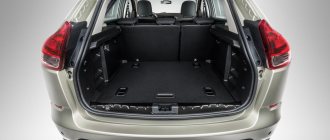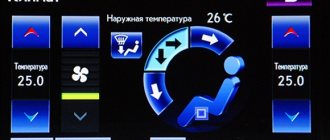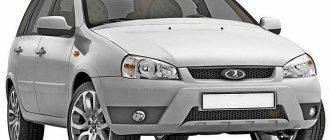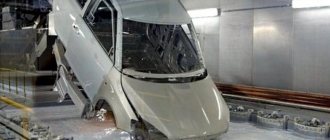LADA XRAY Cross from the official dealer of AutoHERMES
LADA XRAY Cross is a modern and reliable new generation crossover with excellent technical characteristics, increased cross-country ability and excellent handling.
The presentation of the new product took place at the Moscow Motor Show in August 2020.
The main features of the updated model are increased ground clearance (from 195 mm to 215 mm), a modernized powerful subframe and an energy-intensive chassis.
The overall dimensions of the car are:
- Length – 4171 mm;
- Width – 1810 mm;
- Height – 1645.
The X-Ray SUV is equipped with an expanded set of innovative active and passive safety systems: two front AirBags, ABS, EBD, BAS, ESC, TCS, HSA systems, ERA-GLONASS emergency alert, rear view camera, LED daytime running lights, parking radar and other things.
The car demonstrates excellent dynamics thanks to a 1.8-liter gasoline engine with 16 valves producing 122 hp, which is paired with a 5-speed manual transmission. The engine complies with EURO-5 standards.
In the network of AutoHERMES car dealerships, the model is available in three versions: Classic, Comfort and Luxe.
You can get acquainted with the configurations and prices of the Lada X-Ray Cross on the car dealer’s website.
In stock
CLASSIC (2019)
CLASSIC + OPTIMA (2019)
COMFORT (2019)
LUXE + PRESTIGE (2019)
CLASSIC + OPTIMA (2020)
COMFORT (2020)
CLASSIC (2020)
LUXE + PRESTIGE (2020)
LUXE (2020)
CROSS INSTINCT (2020)
If you did not find the car you need in this list, please contact our sales consultants by phone +7(495) 228-03-41
* Offer for a limited batch of cars when purchased on credit under the AutoHERMES-Finance and Trade-In program, details from sales consultants by phone
Characteristics of components and assemblies
The main difference between the two cars is the engine range. In this regard, the hatchback has left the sedan far behind. Vesta has only one engine, while X-Ray has a choice of three power plants. Both models are equipped with a domestic engine with a capacity of 106 hp. With. This is a reliable and time-tested power unit. It has been modernized - previously installed on Priora. This is an in-line 16-valve four-cylinder engine with not the greatest power and maximum speed of 5800 rpm. For everyday driving, it is optimal for both Vesta and X-Ray. This is not surprising, because the mass of the cars is approximately the same. Fuel consumption, acceleration and top speed will be virtually the same with minor variations.
When choosing a pseudo-crossover, two more engines become available to potential buyers. 1.6 liter engine developed by Renault-Nissan. Structurally, it is similar to the domestic 1.6 liter, but has a power reserve, since it was originally designed for 116 hp. With. The extra “horses” were removed in order to adapt the engine to operating conditions in Russia. This option is slightly better than the domestic design, consumes less fuel, shows improved dynamic characteristics, and also allows the engine to “turn” a little more.
The top-end engine is a domestic one with the index VAZ-21179 with a displacement of 1.8 liters. Structurally, this is the same 16-valve unit with a power of 106 hp. s., but the increase in volume affected the addition of another 16 liters. With. Maximum speed at the cut-off of 6000 rpm with a torque of 170 Nm. When fuel consumption is low, the lack of a manual transmission affects it. The robotic gearbox does not allow the full potential of the engine to be revealed, so the dynamic characteristics are mediocre.
For lovers of dynamics and a more powerful engine, it is better to take a closer look at the X-Ray, although you should not expect a significant gap, and if you choose 1.6 liter units, the performance will be even worse.
It is planned to install another engine on the X-Ray, with a capacity of 110 hp. s., but the project is postponed until better times due to the high cost of integration. Equipping Vesta with a 1.8-liter engine can change the situation. Considering the parameters of the sedan, the hatchback is a hopeless loser. For now, the 1.8 liter engine is installed only on Vesta Cross.
The transmission of these models is identical. The set includes manual and robotic gearboxes, all with 5 gears. Vesta can have either a domestic 5-speed manual transmission, or a Renault-Nissan development - JH3 510, as well as a manual transmission.
X-Ray has no domestic gearboxes at its disposal. The French JR5 512 and JH3 518 are installed here, and there are no significant differences between them. There is no noise, gears engage clearly and quickly, and do not slip out. There is nothing remarkable, everything works as it should for a B-class. None of the models have a real automatic transmission. A robotic gearbox is installed - this is done in order to save money; automatic transmissions are more expensive, including maintenance. The “robot” is slightly delayed and does not allow the engine to develop full power, there are jolts and other troubles. AMT is reliable and works without serious complaints.
Options
Unlike the previous comparison parameters, the situation with the trim levels more clearly shows the difference between the cars. Lada Vesta has seven trim levels:
- Classic (minimum basic);
- Classic Start;
- Comfort;
- Comfort Image;
- Comfort Multimedia;
- Lux;
X-Ray is available in five basic configurations:
- Optima;
- Optima Advanced;
- Lux;
- Lux Prestige;
The difference in equipment is really significant. In both cases, the equipment installed is quite good, even in minimal configurations. Among the most interesting additions, Vesta or Lada X-Ray can be equipped with:
- various safety systems (ABS, BAS, EDB, ESC, TCS, HSA);
- driver and passenger airbags;
- halogen head optics for lighting equipment;
- electric power windows;
- on-board and navigation system;
- athermal glasses.
The most interesting thing is that all this (with the exception of navigation) becomes available already in the basic modifications. Distinctive features include the ability to disable the X-Ray's stability control system and the presence of a multifunctional steering wheel with audio system control buttons (in the base). Vesta has only audio preparation in its minimum configuration. X-Ray does not have heated side mirrors and front seats in its base, while Vesta has this standard equipment. In general, the equipment of the models is the same, but depending on the configuration, the difference is noticeable in small details.
AvtoVAZ positions the X-Ray as a crossover, although this is not the case, and therefore, with relatively similar parameters, this allows the manufacturer to set a higher price.
The starting price for X-Ray starts from 599,000 rubles, the top-end version will cost 850,000. For Vesta in a sedan body in the basic configuration you will have to pay 550,000 rubles, and for “Lux Multimedia” - 750,000 rubles.
Exterior
An SUV made in accordance with the brand concept, with a powerful plastic body kit around the perimeter, protective linings on the edges of the wheel arches, sills and the bottom of the doors, looks stylish and brutal.
The following details attract attention on the exterior of the car:
- Head optics . Spectacular front optics with electric headlight leveling are organically complemented by spot fog lights with a cornering light function.
- Aerodynamic antenna . On the roof of the car there is a stylish aerodynamic antenna in the shape of a “shark fin”.
- Rails . Roof rails provide convenient transportation of long loads.
- The back of the car . A black rear bumper with a contrasting silver insert and a chrome exhaust pipe emphasize the sporty character of the crossover.
Interior
The interior of the new XRAY with thoughtful ergonomics provides a high level of comfort for the driver and passengers thanks to such interior elements as:
- Ergonomic seats . Comfortable seats with enhanced lateral support are heated. There is a retractable container under the folding front passenger seat.
- Center console . The updated center console features buttons for turning on the heated seats and windshield.
- Multifunction steering wheel . The adjustable multifunction steering wheel with electric power and heating contains controls for the multimedia system and cruise control.
- Central armrest . The center armrest is equipped with a USB connector, a 12 V socket and buttons for heated rear seats.
Autumn-winter test drive of Lada XRAY with a CVT: all-weather option
February 3, 2020 Vladimir Pshenin photo by the author
After our summer acquaintance with the Lada XRAY AT in Kaliningrad and the surrounding area, it was interesting to find out how it would behave in winter conditions.
When I picked up the car, I was surprised that it was painted not in , but in the more familiar Xray, albeit catchy, “fiery red”. The appearance, by the way, does not suffer from this at all, still making a rather serious impression.
In the cabin, of course, there are also no changes: the massive front panel and not very large dimensions make it fit “tightly”. You won't go wild. But the seat is quite comfortable, and there are enough adjustments for optimal seating geometry.
But it was more interesting, of course, to test the XRAY with a new power unit, consisting of a Renault H4M engine and a Jatco F015E variator, in a cold, sometimes dirty, sometimes snowy season. When there is ice outside, the slowness in the reactions of the variator is more likely to be a plus - you won’t really move anywhere, even if you want to. At the same time, the nonlinear dependence of acceleration on the position of the gas pedal even here makes itself felt.
Let me remind you that the point is that when you try to switch from the creeping mode to acceleration and smoothly press the gas, at first the speed practically does not increase as the speed increases, but upon reaching a certain position of the pedal, a pick-up follows, and then the acceleration becomes clearer. In this regard, even the notorious “robot” performs better, but, of course, is not capable of providing seamless movement. The variator is not familiar with “mechanical” twitching.
dimensions
Let's start comparing Lada Vesta and Lada X-Ray with overall parameters. The cars are different in size because the bodies are different. But since both models are built on the same platform (B0), the differences are not particularly large.
Vesta is longer, and this is due to the presence of a separate trunk. This parameter is 4410 mm, versus 4165 for the hatchback. They are the same in width - 1174 mm, and in height Vesta is only 3 mm lower, this figure for X-Ray is 1570 mm. Their wheelbase also differs: for the sedan it is 2635 mm, and for the hatchback it is 2592 mm. The X-Ray is a “pseudo-crossover”, so its ground clearance is quite good - 195 mm, but Vesta is not far behind it, it has a ground clearance of 178 mm, that is, the sedan is also well suited for our roads.
Another important parameter is the size of the luggage compartment. And this is where the body features come into play. The X-Ray has a minimum volume of 361 liters, while the Vesti has a larger trunk - 480 liters. But in a sedan the volume is static, but in a hatchback the compartment can be increased by folding the rear seat, and significantly. After the transformation, the trunk size increases to 1207 liters. here you will have to choose - either an enlarged compartment, but in the cabin, or a separate one, with also good performance, but without the ability to increase it.
Review of LADA XRAY and XRAY CROSS: configurations and prices
At one time, LADA XRAY was a real breakthrough. Tired of the traditional appearance of AvtoVAZ's creations, motorists were pleasantly surprised by the addition to the range. First the stylish Vesta, later the world saw XRAY and XRAY CROSS. With the advent of the models, the company reached a new level. Now domestically produced cars were bought not only because of their comparative budget, but also because of their attractive design.
Video - What to choose: Lada X-Ray or Lada Vesta
Autoreview experts decided to find out whether the Lada XRAY can surpass the Lada Vesta SW Cross. The Chevrolet Niva SUV also took part in the big test. This is the last production all-wheel drive vehicle developed in Tolyatti twenty years ago. In a comparative review, we decided to show what AvtoVAZ could do then - and what it has come to now.
LADA XRAY
Externally, the new LADA XRAY is quite impressive. From the front, the new spotlight optics and modified radiator grille immediately catch your eye. The exterior has become more expressive due to stampings, original design elements and unusual transitions. The exterior mirrors have become slightly larger. All this, on the one hand, gives the car a fashionable, dynamic character, but at the same time it looks solid and solid.
Under the hood of the LADA XRAY, two types of engines are installed: a 1.6-liter unit with a capacity of 106 horsepower, and a 1.8-liter engine producing up to 122 horsepower. They work in tandem with a five-speed “mechanics” or “robot”.
Already in the basic Standard version, costing from 609,900 rubles, the future owner will have a very good set of options. All versions are already equipped with the ERA-GLONASS system, anti-lock braking system with electronic brake force distribution, auxiliary braking, electronic stability control, traction control, and hill start assistance. Already from the factory, all modifications are equipped with a standard immobilizer and security alarm. There are also two front airbags.
What is the need for comparison?
Why is it necessary to compare cars? The fact is that each of them has its own distinct pros and cons. Sometimes they appear more significantly, sometimes they are practically indistinguishable to an inexperienced driver. In some cases, the disadvantages and advantages of one model overlap with the pros and cons of another, making it impossible to choose a specific comparison winner. In other circumstances, the advantages and disadvantages are expressed more clearly, making one vehicle more preferable for use in certain conditions.
As for the comparison of Lada Vesta and Lada X-Ray, this comparison is especially important for the domestic car enthusiast. The fact is that both cars belong to the new generation of AvtoVAZ products, which significantly changed not only the concept of appearance, but also seriously shook the prejudice among Russians that AvtoVAZ is synonymous with poor quality. Both cars came out with an extremely small time gap (Vesta went on sale in November 2020, and X-Ray appeared in car dealerships in the largest cities in Russia in mid-February 2016). Both cars belong to approximately the same price category and have comparable technical characteristics. Which one a potential buyer should choose will be shown by the results of a detailed and thorough comparison.
The cars proposed for comparison – the 2015-2016 Lada Vesta sedan and the 2020 Lada X-Ray hatchback – can be compared according to a fairly large number of criteria and parameters. Of course, it is worth identifying all the factors and nuances that are of fundamental importance when choosing a particular production model. It is also worth noting the technical characteristics for a qualitative comparison of Lada Vesta and Lada XRay, based on real numerical indicators of vehicle power. Do not forget about the degree of ease of use - both in terms of the body structure itself and in terms of the interior equipment of the cabin with additional functionality. Of course, the appearance of the car, its cross-country ability on Russian roads and, of course, prices – both actual and so-called “operating costs” – will play a big role.
Power units
The proposed power units for equipping both cars are approximately the same, although for the Lada Vesta there is a large choice of configurations. It is worth listing all the proposed engines and transmissions that are installed on both models.
The starting and weakest engine for the Lada X-Ray is a 106-horsepower 1.6-liter engine. The same sixteen-valve engine can also be selected to equip Vesta. The Japanese-made Nissan engine is also repeated, which has the same volume, but produces 110 horsepower for the “high hatchback” and up to 114 horsepower for the previously released sedan.
The most powerful “flagship” engine for the X-Ray will be a domestically designed unit, which appeared in 2020. This is a VAZ-21179 engine with a working chamber volume of 1.8 liters and a final rated power of 122 horsepower. Many thematic automobile publications have repeatedly released information to the public that this engine will also be used in the assembly of the Lada Vesta - this will give the sedan even more capabilities. Even if this information is erroneous, then for Vesta this engine will remain available in the planned version of the Lada Vesta Cross - a station wagon, the release of which into mass production is planned no earlier than the end of 2016.
Another engine that is exclusively equipped with the Lada Vesta is a low-power 1.6-liter eight-valve engine with a power rating of 87 horsepower. It was not used in the X-Ray design due to too low performance characteristics due to the higher curb weight of the hatchback.
Comparing gearboxes
As for gearboxes, there are only two of them for both models being compared. This is a French 5-speed manual transmission, previously used for the assembly of Renault Logan, as well as a domestically produced AMT robotic transmission (automatic transmission), also designed for 5-speed shifts. Both types of transmission are used for both Vesta and X-Ray, so there is no need for comparison.
LADA XRAY CROSS
LADA XRAY CROSS looks more powerful and has greater cross-country ability. This is ensured by increased ground clearance to 215 mm. The car is also equipped with a black plastic protective body kit. On the doors and sills it forms an ascending line, due to which the car visually rises even higher.
Everything in the appearance of the car suggests that it is designed for success in any environment - be it the conditions of a metropolis, or a country road of not the best quality. The relief of the sidewalls of the body continues on the uniquely shaped front bumper. And the chrome lines of the moldings add a sportier look to the car. Daytime running lights are made of LEDs. All trims feature roof rails and 17-inch alloy wheels.
For all trim levels, only one engine-transmission pair is available - a 1.8-liter engine producing up to 122 horsepower, and a five-speed manual transmission.
In the basic Classic version, the set of safety instruments is practically no different from the LADA XRAY hatchback: it also has a set of auxiliary systems, two front airbags, an alarm and an immobilizer. The seat upholstery is also made of fabric in the initial configuration; the driver's seat is not height adjustable. In all versions, the electric power steering steering wheel is adjustable in two planes. Power windows on the front doors only.
Although the differences between the exterior of the maximum Luxe Prestige configuration and simpler versions are practically invisible, inside the future owner will find a rich set of options that increase comfort and convenience when driving. The fog lights have a cornering light function - it turns on automatically when the wheels turn 60 degrees.
The interior is trimmed with leather, LED lighting is installed for the interior, as well as the entrance and exit points at the front. The center armrest has a storage box. There is also a drawer under the passenger seat where you can put things.
As in the top-end version of the XRAY hatchback, the XRAY CROSS crossover is equipped with a multimedia system with a 7-inch touch screen, multifunction steering wheel, climate and cruise control, rear view camera and other functions. But now there are heated seats on the rear “sofa”. Also for rear passengers there is now a 12V socket and USB.
LADA XRAY and XRAY CROSS will be an excellent option for those who want to purchase a comfortable car with good capacity and cross-country ability. Possessing a rather stylish appearance, both models will look great against the backdrop of the metropolis landscape. But at the same time, they will also cope well with suburban off-road conditions, fully justifying the advertising slogan.
Characteristics of Lada Vesta and X-Ray
A comparison of technical characteristics is presented in the table:
| Comparison parameter | Lada Vesta | Lada X-Ray | ||||
| 106 l. With. 5-speed manual transmission | 106 l. With. robotic gearbox | 122 l. With. Manual transmission | 106 l. With. Manual transmission | 106 l. With. robotic gearbox | 122 l. With. robotic gearbox | |
| Acceleration from 0 to 100 km/h | 11.2 sec | 14.1 sec | 10.4 sec | 11.4 sec | 14.1 sec | 10.9 sec |
| Maximum speed according to passport | 174 km/h | 178 km/h | 185 km/h | 176 km/h | 178 km/h | 186 km/h |
| Average fuel consumption | 6.9 l | 6.6 l | 7.4 l | 7.2 l | 6.6 l | 6.8 l |
The technical characteristics are generally the same, there are no significant differences in dynamics. The situation is different with handling and driving performance. Both models use front-wheel drive with independent suspension, complemented by anti-roll bars. The rear suspension is semi-independent with shock absorbers and gas-filled shock absorbers. The suspension system is completely unified for both cars, but there is a significant difference in the settings.
The Lada XRAY hatchback has received a more rigid setting and is designed to pass through holes and bumps without much recoil. It is positioned as a car for suburban use. On city streets, the XRAY is not so comfortable and clearly transmits all the minor unevenness of the road surface to the body.
The Vesta sedan received a soft suspension. It is optimally configured for driving on asphalt surfaces. But passing significant obstacles is much more difficult for the sedan’s suspension, since it is simply not designed for this.
Interior and exterior
Buyers still cannot determine which of these models is more prestigious when comparing both cars. Their main differences are in the body. Previously, Vesta was produced exclusively in a sedan body, but now a station wagon, a pseudo-off-road station wagon Vesta Cross, a sedan with a long wheelbase Vesta Signature and a Sport version have become available.
In this regard, the X-Ray is still the only hatchback in its body, not counting the Cross version. This model cannot be defined as a crossover; it has nothing in common with this class - except that the dimensions are a stretch. As for the X-Ray Cross, apart from plastic body kits and minor changes to the interior, there are no significant differences in this body.
Size comparison
Dimensions are ambiguous; both bodies have both disadvantages and advantages over each other:
| Parameter | Vesta | X-Ray |
| Length | 4410 mm | 4165 mm |
| Width | 1764 mm | 1764 mm |
| Height | 1497 mm | 1570 mm |
| Distance between wheel axles | 2635 mm | 2592 mm |
| Ground clearance | 178 mm | 195 mm |
| Luggage compartment volume | 480 l | 391 l |
| Weight/maximum weight | 1230 kg/1670 kg | 1190 kg/1650 kg |
Judging by the comparison table, the hatchback is inferior to the sedan in many respects. If the spaciousness of the car and the comfort of rear passengers are important, it is better to choose Vesta, although tall passengers may experience inconvenience due to the sloping, falling roof. If ground clearance and trunk capacity are more important, X-Ray is better. The hatchback has a folding rear seat, and the trunk volume increases to 1207 liters. The transportation of large-sized cargo is allowed - Vesta’s trunk cannot boast of such advantages.
Photo 2 (Interior)
Appearance
Externally, both cars are similar to each other. After the recent restyling, the front part has become almost identical - the lines creating the letter X, the shape of the fog lights, the radiator grille combined with the air intake on the bumper. The difference can be seen if you look from the side – the “front” of the hatchback seems to end abruptly. The doors and fenders have the same stampings in the shape of the letter “X”. The image is beautiful, but the developers did not take into account the visual effect - this design visually makes the car shorter. In the case of X-Ray and his flattened front, this is especially noticeable.
The wheels on the sedan combine well with the body, which cannot be said about the hatchback. The car has high ground clearance and large wheel arches. In the minimum trim levels, the hatchback is equipped with 15-inch wheels, and in the top trim levels – 16-inch wheels. In practice, it turns out that the optimal option is 17 inches.
In terms of its dynamic characteristics, the X-Ray loses to the Vesta due to its high ground clearance and short wheelbase. The sedan has better aerodynamic characteristics due to increased streamlining, the center of gravity is lower, and the car is more stable at high speeds on the highway. Vesta loses only on off-road, where high speed is not important, and the ability to overcome obstacles is much more valued. In city traffic, two cars behave the same.
Interior
As for the interior, the Lada Vesta and X-Ray are completely identical. The difference can only be noticed in the little things. For example, different door opening handles, different shapes of the side deflectors, different lines of the center console and the location of some buttons. These nuances do not affect the overall interior architecture. You can also note the presence of an armrest in front of the central tunnel in Vesta - the hatchback does not have it.











